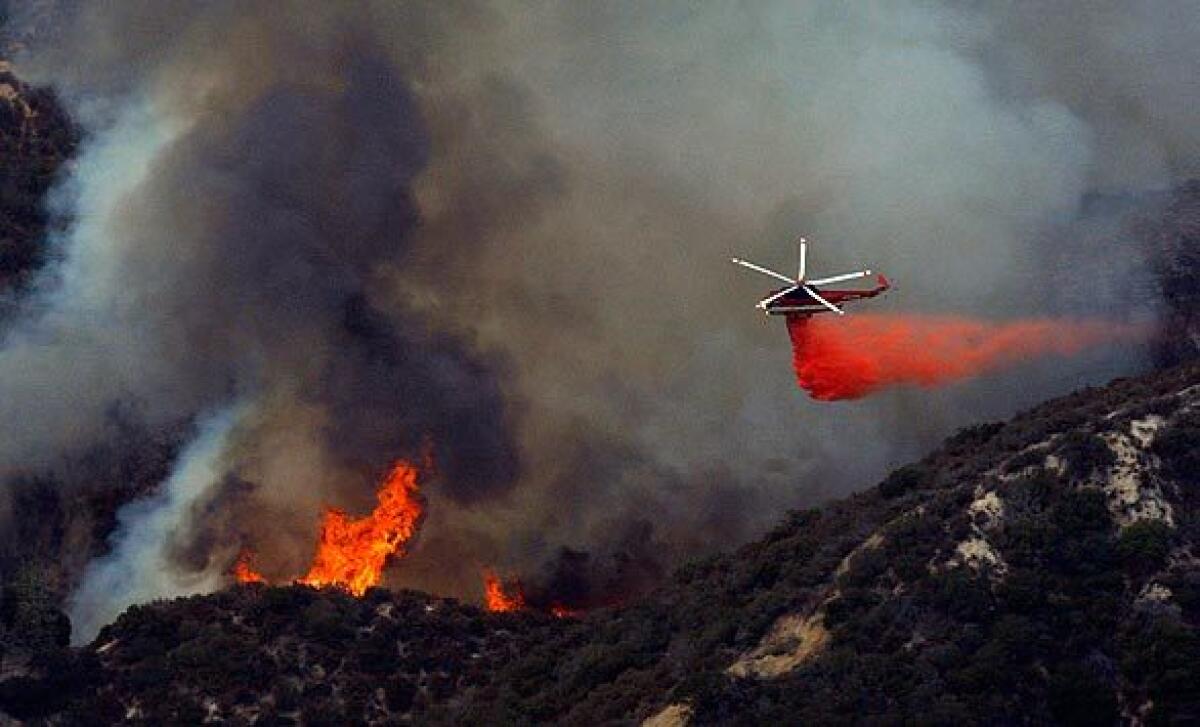Forest Service may end ban on using firefighting aircraft at night

- Share via
The head of the U.S. Forest Service told a Senate panel Wednesday that water-dropping helicopters would have been deployed during the critical first night of last summer’s disastrous Station blaze if they had been available and that the agency is considering ending its decades-long ban on using federal firefighting aircraft after dark.
Under sometimes pointed questioning by Sen. Dianne Feinstein (D-Calif.) and Rep. Adam Schiff (D-Burbank), Forest Service Chief Tom Tidwell also defended the agency’s handling of the fire the next morning, when a heavy aerial assault did not begin until several hours after daylight. He said aircraft alone would not have stopped the flames from racing through the Angeles National Forest.
Schiff later expressed doubt that an earlier air attack on Day 2 would have been ineffective because of steep terrain, as the Forest Service determined after an internal review. “The conclusion that it would not have helped anyway is a little too facile,” he said.
Schiff said he was confident that the Forest Service would resume flying at night, a tactic it abandoned in the 1970s after a fatal crash. “We are moving toward a change in policy,” he said.
Feinstein, who chairs the Senate subcommittee that held Wednesday’s hearing, said that equipping the Forest Service with night-flying aircraft is a “real priority,” especially in California. She said global warming and enduring droughts have heightened the danger of huge wildfires that threaten neighborhoods.
“Fires are not going to get better, they’re going to get worse,” she said. “The air assets are critical, and they have to be in place, they have to be accessible.... We have to do better.”
Feinstein noted that cost estimates for a new fleet of Forest Service air tankers exceed $1.5 billion but said she would push for the funding.
Tidwell said the Forest Service is weighing that option and several others for a return to flying during darkness, including an increased reliance on aircraft owned by local agencies, such as the Los Angeles County Fire Department, which routinely flies at night. He said recommendations could be released by year’s end.
Regarding the Station fire, which broke out on Aug. 26, Tidwell said, “If we would have had helicopters available that night, we would have used helicopters.”
He said the county department had turned down an informal Forest Service request to assign a night-flying copter to the fire. County Chief Deputy John Tripp, however, said in a subsequent interview that there is no record of the request.
Tripp also disputed a Forest Service account that a county chopper left the blaze the first night because it was needed for non-fire medical evacuations. He said the copter actually went to the fire after a medical call and left when the Forest Service released all choppers at nightfall.
“They have their facts wrong,” Tripp said.
The Forest Service will look into the matter further, spokesman David Sandretti said. “There’s a conflict,” he said.
The fire was the largest in county history, blackening 250 square miles and destroying scores of homes and other structures. On its fifth day, two county firefighters were killed while defending their mountaintop camp.
Schiff plans to convene a panel of Los Angeles area-based House members to examine the Forest Service’s actions. He said he would take testimony from a group of former Forest Service officials who have been critical of the agency’s performance and have called for an independent investigation.
An organizer of the retired officials, William Derr, a former special agent in charge of law enforcement for the Forest Service’s California region, said Feinstein’s hearing “appropriately focused on air resources, but not enough time was devoted to the overall effectiveness of the suppression efforts.”
Last fall, The Times reported that the Forest Service misjudged the threat posed by the blaze and rolled back the Day 2 response.
The Times also reported that a commander placed an overnight “special needs” order for air tankers and helicopters to hit the fire by 7 that morning, but most of the aircraft did not arrive until about 9 a.m., after the flames had jumped a crucial defense line and had begun growing exponentially.
The Forest Service has offered shifting explanations for the delayed assault.
A Forest Service official said in September that commanders initially believed a bigger attack from the sky would not be needed after sunup on Day 2. Then the internal inquiry completed in November concluded that more choppers and tankers would have been useless during those hours because ground crews could not safely finish extinguishing the flames.
More recently, the Forest Service has said that the three air tankers were not at the fire by 7 a.m. because their crews had not rested for the mandatory number of hours after working a nearby blaze the day before. The agency has said numerous air tankers assigned to the region had been committed to other fires.
--
More to Read
Sign up for Essential California
The most important California stories and recommendations in your inbox every morning.
You may occasionally receive promotional content from the Los Angeles Times.










